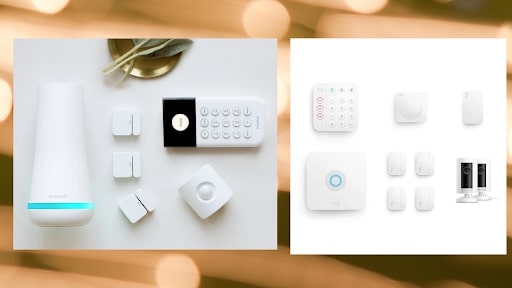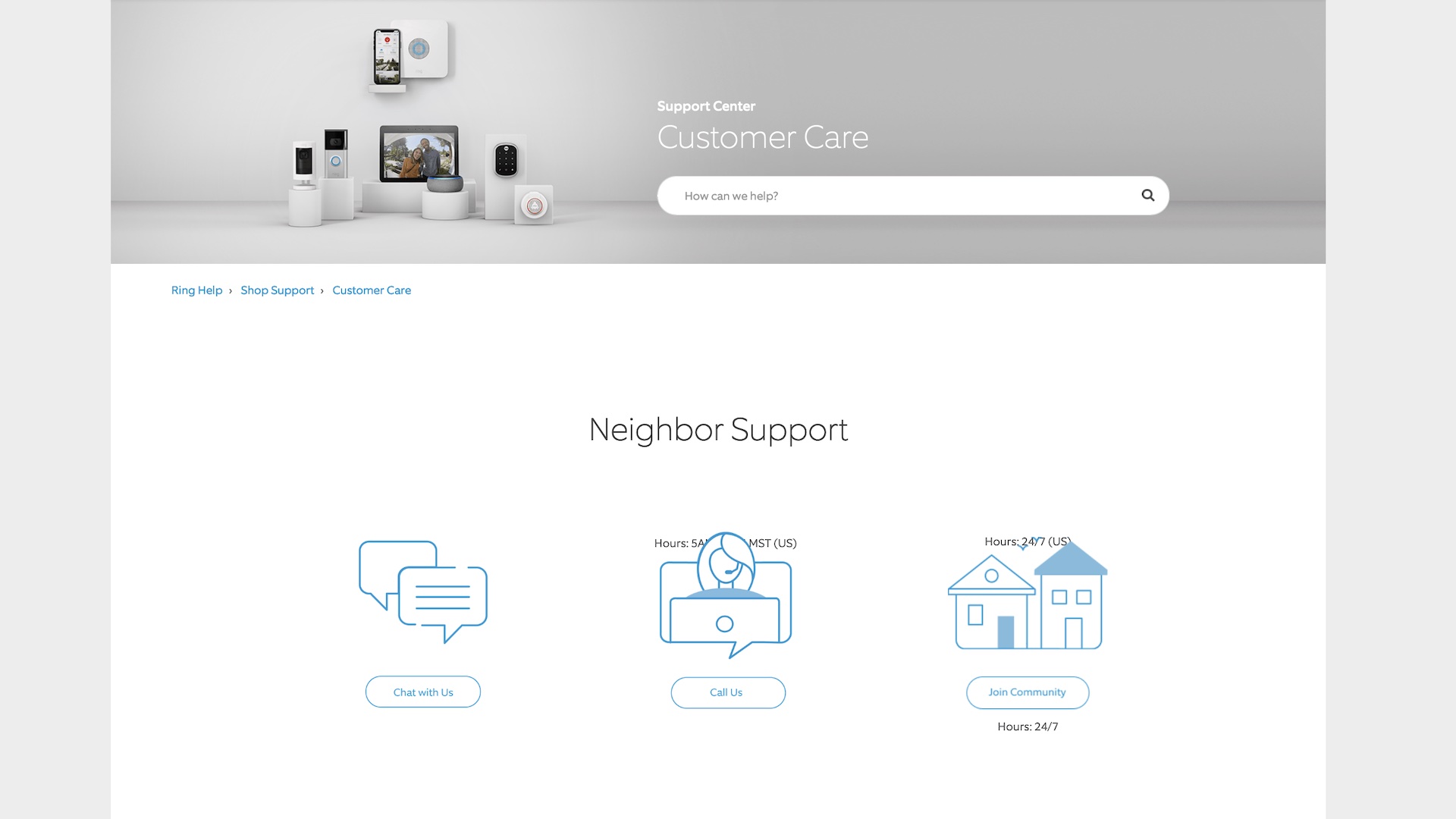SimpliSafe vs Ring
We compare SimpliSafe and Ring to help you decide which business security system for best for you

By protecting premises and assets, the best business security systems provide business owners with peace of mind. The DIY security systems offered by SimpliSafe and Ring are excellent options for those looking for cost-effective ways to keep their premises safe.
In this SimpliSafe vs Ring comparison, we’ll compare the features, performance, support, and pricing plans of these two leading providers so that you can decide if these security systems are good solutions for your business security needs.
SimpliSafe vs Ring: Features
| Header Cell - Column 0 | Easyself-installation | Professionalinstallation | Built-incellular connection | Mobileapplication |
|---|---|---|---|---|
| Yes | Yes ($79) | Yes | Yes (only for InteractiveMonitoring plan subscribers) | |
| Yes | Yes ($34.99 to $249.99) | No | Yes |
DIY security systems are popular for their easy set-up and installation. With SimpliSafe, all you’ll have to do is unbox and plug a base station into a standard AC outlet. Step-by-step instructions will also be provided for you to know where and how to place sensors and other pieces of hardware. You won’t need to have a toolbox ready with SimpliSafe’s peel-and-stick sensors.
Ring’s alarm system is just as easy to install, and to set up the base station, all you need to do is plug it into a power outlet and connect it to a Wi-Fi network. Like SimpliSafe’s sensors, Ring’s other components—contact sensors, motion detectors, range extenders, and keypads—use easy peel-and-stick installation.
For business owners who would rather leave it to the professionals, both SimpliSafe and Ring offer professional installation. Depending on the device in question, Ring’s installation fees range from $34.99 to $249.99. SimpliSafe, on the other hand, charges $79 for installation.
Connectivity

To operate your Ring device, you’ll have to make sure that it is connected to a stable Wi-Fi network. If you’d like a cellular backup system to roll in when your Wi-Fi goes offline, you’ll have to sign up for the service’s Protect Plus Plan at an additional $10/month.
SimpliSafe’s base station conveniently features a built-in cellular connection which is used to control sensors and communicate with the provider’s monitoring service. In other words, you do not need access to a Wi-Fi network for SimpliSafe’s system to work. Even if you lose power, SimpliSafe’s cellular monitoring enables you to stay connected. Those who prefer to connect their system to a Wi-Fi network can still choose to do so. This feature is great for business owners who are concerned about unstable Wi-Fi connections.
Mobile application
Both SimpliSafe and Ring offer mobile applications that enable you to remotely control your security devices. On both apps, you’ll be able to toggle your system on and off, view footage of anyone entering or leaving your premises, check your event log, and more. If your mobile phone runs out of battery, you can access your account and devices through a separate online portal that both providers offer.
Business owners will appreciate that Ring’s app allows you to designate the levels of access you would like each employee to have. If an employee is assigned a guest profile, they’ll be granted limited access to the app. You’ll still be able to provide them with a unique access code (on the app) for them to arm or disarm your system through Ring’s keypad.
The added level of control that Ring’s app provides makes it the one to beat. Furthermore, it is free to use for all of Ring’s customers. SimpliSafe, on the other hand, offers its app only to users who pay for Interactive Monitoring—a paid monitoring plan that you can add on to your system.
SimpliSafe vs Ring: Performance
Communication range
Long-range communication is vital for a security system’s performance. Ring’s system employs Z-Wave technology, which supports communication of up to 250 feet. While that is more than adequate for most business owners, it may be unsuitable for those with larger premises.
These users will find SimpliSafe’s base station, which can reach up to 100 sensors that are 400 to 500 feet away, more suitable. The sensors remain connected across rooms on different levels and work through thick walls found in certain commercial spaces.
Device integration
Because Ring is owned by Amazon, its security systems integrate well with Amazon devices, including Echo Show, Echo Spot, Echo speakers, FireTV, or FireTablet. Additionally, on the Ring’s Works with Ring collection, you’ll find a bunch of smart devices that integrate seamlessly with your Ring security system. Some examples include smart locks, light switches, smart outlets, and sirens.
Like Ring, SimpliSafe offers device integrations. But you’ll find that Simplisafe integrates with far fewer devices—Google Assistant, Amazon Alexa, Apple Watch, and August smart locks. Moreover, device integration is only available with the service’s Interactive Monitoring plan.
SimpliSafe vs Ring: Support

SimpliSafe users can contact support via email and phone (8am to midnight ET). You can also hop onto SimpliSafe’s user forum to share your questions with other users or navigate a Help Center with general questions and dedicated sections with guides for each of SimpliSafe’s products.
While adequate, SimpliSafe’s customer support can’t beat Ring’s 24/7 phone support. Users can also access live chat support (5am to 9pm MST), community boards, guides, video tutorials, and FAQs on Ring’s website.
SimpliSafe vs Ring: Pricing and plans
| Header Cell - Column 0 | Ring Free | RingBasic Protect | RingProtect Plus | SimpliSafeUnmonitored | SimpliSafeSelf-monitoring | SimpliSafeStandard monitoring | SimpliSafeInteractive Monitoring |
|---|---|---|---|---|---|---|---|
| Cost per month | $0 | $3 | $10 | $0 | $9.99 | $14.99 | $24.99 |
| Cost per year | $0 | $30 | $100 | $0 | $119.88 | $179.88 | $299.88 |
| 24/7 professional monitoring | X | X | ✓ | X | ✓ | ✓ | ✓ |
| App access | X | ✓ | ✓ | X | X | X | ✓ |
| Device integration | ✓ | ✓ | ✓ | X | X | X | ✓ |
| Cellular connection | X | X | ✓ | ✓ | ✓ | ✓ | ✓ |
| 24/7 phone support | ✓ | ✓ | ✓ | X | X | X | X |
Packages
Depending on your business type, you can choose from four of SimpliSafe’s packages. At $155, the Business Essentials package comes with basic hardware like a base station, motion and entry sensors, and a keypad. One tier up, the Office System ($236) throws in an extra panic button. Likewise, SimpliSafe’s Storefront System ($260) and Restaurant System ($293) includes additional hardware such as Glassbreak sensors and a key fob.
Compared to SimpliSafe, Ring’s packages are pricier. An eight-piece Business Alarm Security Kit suitable for businesses with up to four entry points and motion detection for one hallway costs $249.99. Ring’s other business package will cost you $349.99 and features two additional indoor cameras for video monitoring.
Contract length
With both providers, you’ll not be tied to any long-term contract and can choose to cancel your subscription at any time. You’ll also have the option to sign up for a monitoring plan. Ring’s Basic Protect Plan ($3 a month) allows you to save and share videos and view snapshots that were captured throughout the day.
Monitoring options
The Protect Plus Plan ($10 a month) includes 24/7 professional monitoring for your Ring Alarm and extended warranties for your devices. If you choose not to sign up for a monitoring plan, you’ll still enjoy basic features like mobile notifications, live video feed, and lifetime theft protection.
As with Ring, if you choose to forgo a SimpliSafe monitoring plan, you’ll still get basic features like live video feed. To unlock more features, choose among three of SimpliSafe’s business monitoring packages. The priciest Interactive Monitoring plan ($24.99 a month), provides 24/7 monitoring from SimpliSafe’s control center, priority police dispatch, HD live view on all cameras, and unlimited camera recordings among other features.
For $14.99 a month, the Standard Monitoring plan does away with Visual alarm verification. In other words, when your alarm is set off, SimpliSafe’s team at the monitoring center will dispatch the police without visual evidence of what set the alarm. Response times will therefore be slower.
Finally, SimpliSafe’s Self-monitoring plan ($9.99 a month) offers HD live view on all cameras and unlimited camera recording. In the event of a break in, you’ll have to contact the police on your own.
Pricing verdict
In terms of pricing, there isn’t a clear winner—while Ring’s hardware is more expensive than SimpliSafe’s, its monitoring packages are more affordable. With multiple hardware and monitoring packages to choose from, both providers are great for users with different needs and budget constraints.
SimpliSafe vs Ring: Verdict
With a variety of pricing packages for different hardware and monitoring plans as well as fuss-free installation and set-up, both SimpliSafe and Ring are easy to recommend.
SimpliSafe, with a longer communication range and built-in cellular connection, is the better choice for business owners with larger premises or premises that receive poor Wi-Fi signals.
That said, users who prioritise device integration will enjoy Ring’s seamless integration with multiple smart devices. Particularly, if you’re already using a range of Amazon devices, Ring’s security system will be a great addition to your business. Those who are frustrated by SimpliSafe’s lack of a free app for all users and 24/7 phone support will also appreciate that Ring provides all users with both.
Further reading
If you're looking for other business security options, then check out our guide to the best security systems for business. And you can find out more about SimpliSafe in our full SimpliSafe review.
Get the ITPro daily newsletter
Sign up today and you will receive a free copy of our Future Focus 2025 report - the leading guidance on AI, cybersecurity and other IT challenges as per 700+ senior executives
Joanna is a freelance writer based in Singapore, with a background in Sociology and a keen interest in technology. A seasoned and passionate writer, Joanne has worked with such global publications as TechRadar, Tom's Guide, CreativeBloq, and more. When she's not writing, she's usually binge-watching trashy reality shows on Netflix.
-
 Google Cloud is leaning on all its strengths to support enterprise AI
Google Cloud is leaning on all its strengths to support enterprise AIAnalysis Google Cloud made a big statement at its annual conference last week, staking its claim as the go-to provider for enterprise AI adoption.
By Rory Bathgate Published
-
 Bigger salaries, more burnout: Is the CISO role in crisis?
Bigger salaries, more burnout: Is the CISO role in crisis?In-depth CISOs are more stressed than ever before – but why is this and what can be done?
By Kate O'Flaherty Published